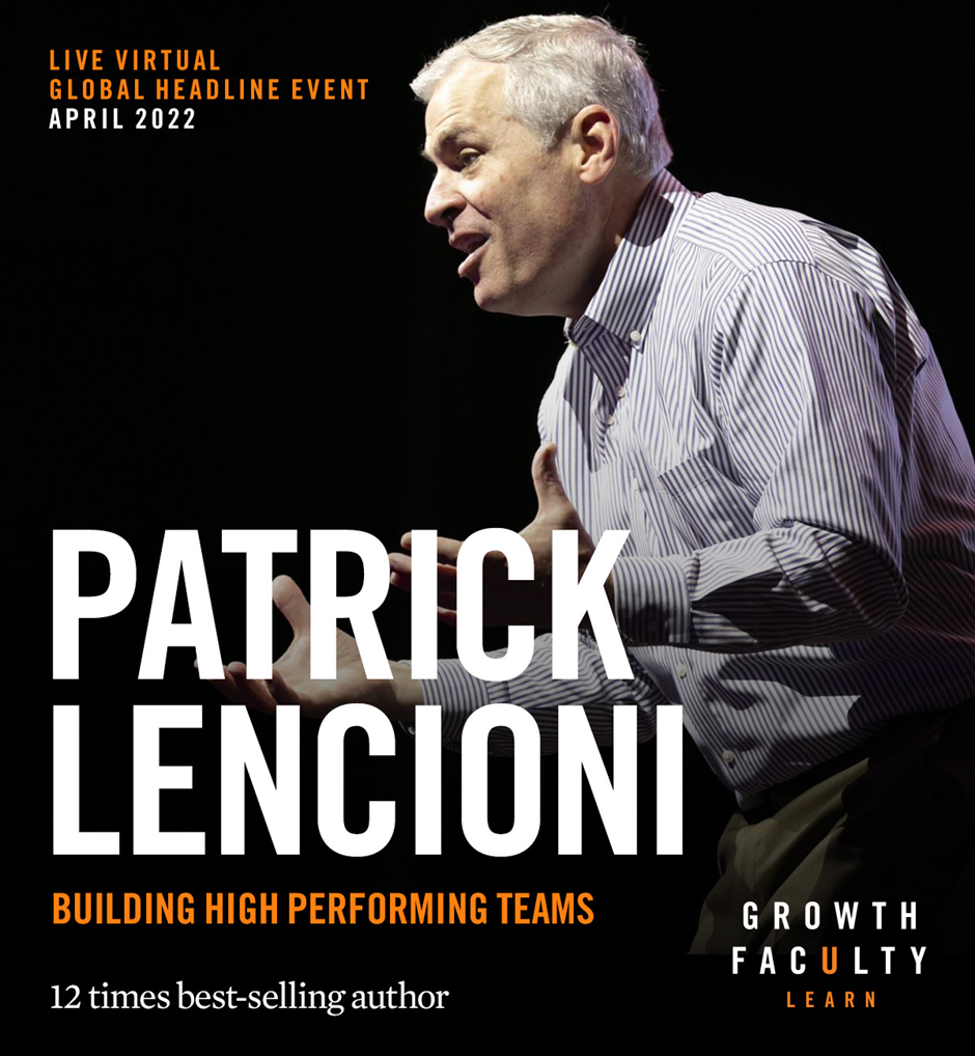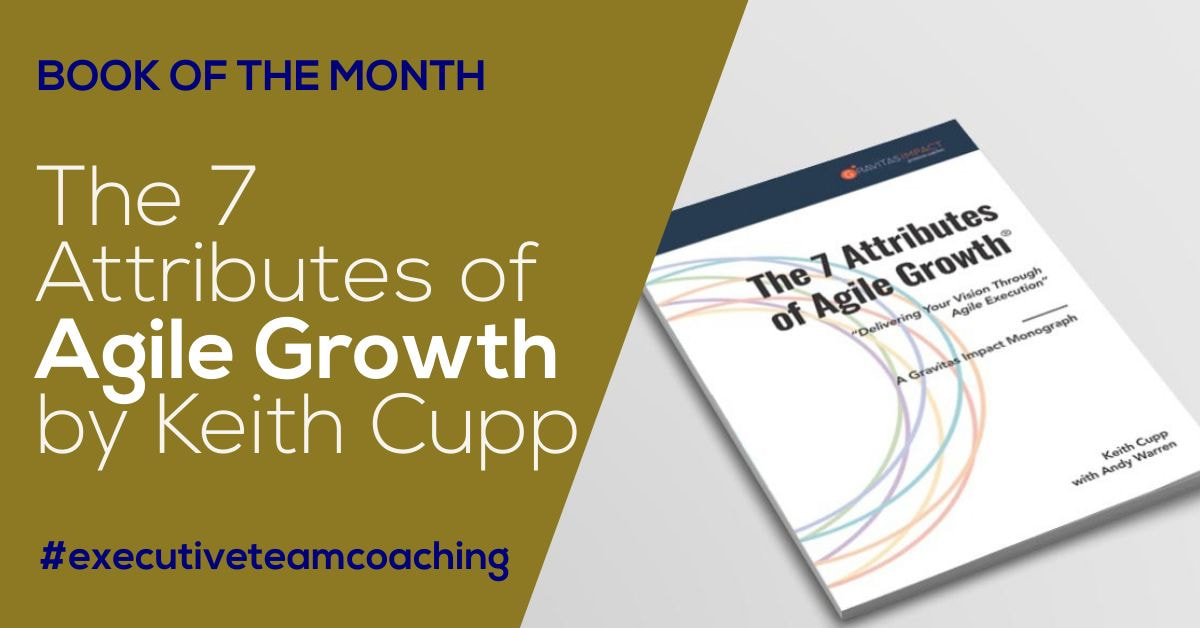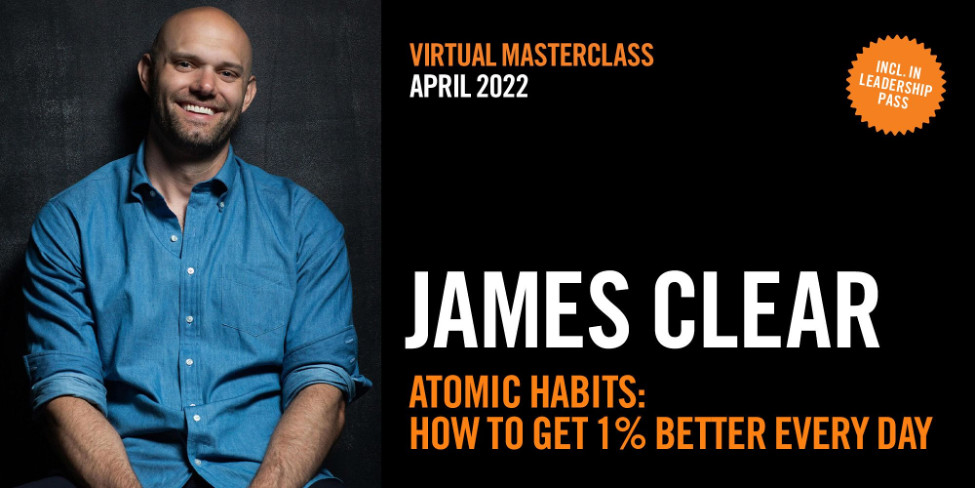|
TEAMWORK AND HIGH-PERFORMANCE CULTURES IN THE POST-PANDEMIC ENVIRONMENT In partnership with Growth Faculty, we are delighted to offer you a $50 discount to Building High Performing Teams, a 2.5 hour interactive virtual event with Patrick Lencioni. This April, join us as 12x New York Times bestselling author, Patrick Lencioni, presents an unmissable live virtual event; Patrick Lencioni: Building High Performing Teams. Pat's work has transformed thousands of workplaces globally through practical frameworks to elevate teamwork, attract star performers, multiply intellect, maximise talent and ensure high performance flourishes. Back by popular demand, over 2000 Growth Faculty professionals have rated Pat as 9.6/10. Pat will bring game changing research to transform your team and your business. Don't miss Patrick Lencioni. "one of the most in demand speakers in America." Wall Street Journal - "one of the most coveted speakers in the world." Forbes Tuesday, April 26, 2022 - 6pm in MB, 5pm in SK NON-MEMBER: $295* | OUR NETWORK: $245* *Prices quoted in USD. How can you build a high performing team?
To find out how you can build a healthy, high organization to grow more easily, quickly and profitability, AND enjoy the ride, try our complimentary Agile Growth Checklist. This self-service questionnaire takes 5 to 10 minutes to complete. You'll receive the checklist with your responses immediately. Within 24 hours, you'll receive a compiled report highlighting areas to improve. Find out how your company is doing in each of the 7 areas needed to produce more rapid, profitable and sustainable growth. This report is complementary and involves no obligation. I’ve found that a growing number of CEOs and executive teams are becoming familiar with leadership operating systems for midsize companies; systems like The Rockefeller Habits, Scaling Up or the Entrepreneurial Operating System (EOS), that are summarized in books by the same names.
These systems have been built on each others’ shoulders: the Rockefeller Habits compiling best practices from a variety of thought leaders, EOS expanding on the habits and making them more accessible to small businesses, and Scaling Up adding more best practices to strengthen strategy, profitability and cash flow. When CEOs and their teams successfully implement these methods, then growth, and even profitable growth becomes easier, especially if they're working with a leadership team coach. However, as companies grow, the journey becomes more complex and some gaps can become apparent in these systems. I’ve also found that some companies struggle to implement these methods because certain elements aren’t covered in much depth; things like accountability, how to set metrics, targets and rocks, and how to get executive team alignment. While I use the Scaling Up method and the Rockefeller Habits with the companies I work with, as well as some of the tools that are unique to EOS, I also rely on a system that builds on their shoulders to fill the gaps and address some of the more subtle challenges of growth: The 7 Attributes of Agile Growth. The book, again by the same name, was written by Keith Cupp, CEO of Gravitas Impact Premium Coaches, the global community of executive team coaches I am a part of. The 7 Attributes of Agile Growth is a monograph, a relatively new format of book, being made popular by certain thought leaders, like Jim Collins with his Flywheel monograph. Monographs are relatively short, at 40 to 80 pages, designed to cover a narrow topic or provide a high level overview, and be read in one sitting, like on a short-haul flight. The book outlines the attributes of companies that are successful at not only growing, but also overcoming the new challenges that come with growth and adapting to a constantly changing environment in order to keep growing sustainably and profitably over time. These 7 Attributes include Leadership, Talent, Strategy, Execution, Profit, Customer and Systems. The leadership attribute is where the executive leadership team has done the work to become authentic, healthy, and aligned. Talent is about leaders and managers pursuing a culture of trust, results, and accountability with their people. The strategy attribute is where the executive team has defined and evolved a unique and valuable position in the market, and it can be easily recalled and stated by all employees in one phrase. Execution includes having annual, quarterly, and personal targets and priorities that are visible, measured, and activated successfully with a 13-week sprint. The profit attribute is where cash flow has been optimized, and the executive team understands the forces and levers in their control to increase profit and cash. The customer attribute is where the core customer has been defined, a compelling promise has been crafted, and the customer lifecycle has been systematized. Systems is where the organization has defined methods to optimize core processes, change management, decision-making, and technology use. The 7 Attributes of Agile Growth is an introductory monograph to the overall operating system. Separate monographs are being developed for each attribute. So far, four monographs have been released, going into some depth on: accountability, profit and cash flow optimization, A player talent, and competitive strategy. Monograph: 56 pages. How can you grow an agile company? To find out how to implement a leadership operating system to grow more easily, quickly and profitability, AND enjoy the ride, try our complimentary Agile Growth Checklist. This self-service questionnaire takes 5 to 10 minutes to complete. You'll receive the checklist with your responses immediately. Within 24 hours, you'll receive a compiled report highlighting areas to improve. Find out how your company is doing in each of the 7 areas needed to produce more rapid, profitable and sustainable growth. This report is complementary and involves no obligation. Whenever I start working with a CEO and their executive team, they realize very quickly that most of their efforts to strengthen their company ultimately hinge on people. Their efforts to manage things, to move things forward, to change things, to improve things… these all need more than things. They need great people. They’ve known this. They believe this. But somehow, they’ve never put it at the top list. And yet, it gets in the way of progress every time. In this Gravitas Impact Premium Coaches podcast, Jay Niblick, founder and CEO of Innermetrix and co-founder of WizeHire, walks through the key elements of the People Problem, and how to address it successfully within your business. Subscribe to Gravitas Impact podcast: Android How can you solve your people problem?
To find out how to strengthen your people to grow more easily, quickly and profitability, AND enjoy the ride, try our complimentary Agile Growth Checklist. This self-service questionnaire takes 5 to 10 minutes to complete. You'll receive the checklist with your responses immediately. Within 24 hours, you'll receive a compiled report highlighting areas to improve. Complete section 2 to check your company’s people processes. Or complete all 7 sections to find out how your company is doing in each of the 7 areas needed to produce more rapid, profitable and sustainable growth. This report is complementary and involves no obligation. BUILDING BETTER HABITS: HOW TO MAKE CHANGE AT A MOLECULAR LEVEL In partnership with Growth Faculty, we are delighted to offer you a 10% discount to How To Get 1% Better Every Day with James Clear, author of Atomic Habits. Nine out of ten habits don’t last. Why? Often, it is because we try to change too much too quickly. It becomes unsustainable, and we fall back into old ways we know don’t work. Introducing James Clear; #1 New York Times bestseller of Atomic Habits and expert in habit formation. In this 90 minute masterclass he will explain the psychology of how our brains form habits. By making incremental changes at an atomic level, we can ensure that these habits will stick. Fine margins can have profound results. This is a must-not-miss for anyone who has been held back by their own bad habits. Over 5 million people have bought his book Atomic Habits. By aiming to be 1% better each day, they are rewiring their brains to be more productive than they were yesterday. Tuesday, April 5, 2022 - 6pm in MB, 5pm in SK NON-MEMBER: $130 | OUR NETWORK: $115 *Prices quoted in USD. How can your team strengthen their execution habits?
To find out how to improve your executive team’s habits to grow more easily, quickly and profitability, AND enjoy the ride, try our complimentary Agile Growth Checklist. This self-service questionnaire takes 5 to 10 minutes to complete. You'll receive the checklist with your responses immediately. Within 24 hours, you'll receive a compiled report highlighting areas to improve. Complete section 4 to check your company’s execution habits. Or complete all 7 sections to find out how your company is doing in each of the 7 areas needed to produce more rapid, profitable and sustainable growth. This report is complementary and involves no obligation. In the 11 years I’ve been an independent coach and advisor, I’ve seen many companies that grow to a certain point and, despite all their best efforts, can’t seem to grow beyond that. I’ve also seen companies that do continue to grow but become less and less profitable, and more and more stressful for the owner or CEO. Turns out this isn’t just my experience. It’s a common pattern. Growth isn’t common Out of the roughly 28 million firms in the US, only about 1.1 million have surpassed a million in revenue. Only 112,000 have gotten past $10 million. And only 17000 have grown beyond $50 million. The reason is that companies need to operate differently as they grow. Companies that don’t adapt how they operate will tend to grow to the limits of that way of operating. Owners, presidents and CEOs who have had success getting to a certain point often tend to repeat what they know, thinking “well, it got us here.” But, as the title of a book by Marshall Goldsmith goes, “what got us here won’t get us there”. The systems to manage a growing team The changes needed for a growing company are driven by the added complexity that comes with having more employees. Think simply of going from 2 to 4 employees. This makes the number of relationships between individuals increase from 1 to 10. This complexity continues exponentially as the company grows from 10 to 25 to 50, 100, 200 employees or more. To predictably achieve results within this growing complexity, a certain level of order is needed. Processes, systems and structures create that order in companies. And the systems needed to create order in the complexity of a 200 person organization are different than that of a 100, 50, 25 or 10 person organization. For example:
Hitting the ceiling, valleys of death Any company within one stage will usually hit a ceiling if they keep doing things the same way they always have. Companies that don’t make the right changes, or aren’t successful in making those changes, will fall into what we call a “valley of death”. Valleys of death are where the leadership makes big investments, but they don’t work out. So the company doesn’t move beyond that stage. The company can also fall backward in terms of revenue and often profitability because of the failed investments. Worst case, it can lead to company failure. Growing unprofitably Some companies grow despite not making the changes needed for the next stage. With sheer grit or dramatic demand growth, they’ll grow. However, these companies often become increasingly inefficient with the increasing complexity and resulting chaos. And so the company’s profitability will decrease, sometimes significantly. Unless exceptionally well funded, with investors willing to accept short to mid term losses for a longer term windfall, the decreasing profitability and resulting cash flow challenges will eventually prevent the company from investing in the capacity to grow and the systems to grow profitability. And so growth will stall. One can also count on drama, stress and headaches being the overarching theme for the leaders. So what stops a company from making the right changes and improvements to grow successfully and profitably? The CEO and leadership team are the linchpin From these stages and key changes, we can see early in a company’s life - by about 25 employees - that an owner or CEO has to learn to get results from people through other managers. That means the changes and improvements the company makes will depend on the CEO working WITH top level managers as a team…a leadership team (or management team, executive team, or whatever you want to call it) . And, very often, leadership teams in mid-size companies are working in silos and at cross purposes. They often are too focused on the day-to-day, so the big projects to move the company forward often don’t get done or aren’t done right. The result is the company doesn’t identify or successfully implement the right processes, systems and structures to handle the increasing complexity of a growing company. It’s the CEO’s job to pull their leadership team together, get them all going in the same direction, moving in lockstep, making the needed changes and improvements to enable their broader team to keep growing. An always-evolving leadership team The challenge of having an effective leadership team continues through the life of the company. New leaders come and go. Markets evolve. Systems need to change. And so the capabilities of the leaders and the team need to evolve as well. The crucial underlying challenge to achieving profitable growth is to build, maintain and continuously improve a great top team that is highly capable, aligned, leading and executing effectively and efficiently, and therefore minimizing silos and strengthening execution between and across departments. Essentially, working as one unit to move the company forward because the owner CEO can’t do it alone…because it’s too much for the owner or CEO to do it alone, at least effectively and sanely. More about that in my next 5 Minute Growth Tip article. What systems can you improve to grow a thriving company? To find out what systems you and can improve to grow more easily, quickly and profitability, AND enjoy the ride, try our complimentary Agile Growth Checklist. This self-service questionnaire takes 5 to 10 minutes to complete. You'll receive the checklist with your responses immediately. Within 24 hours, you'll receive a compiled report highlighting areas to improve. Find out how your company is doing in each of the 7 areas needed to produce more rapid, profitable and sustainable growth. This report is complementary and involves no obligation. *These examples of structures, systems and processes are drawn my own experience over my last 16 years coaching, facilitating and advising, and from the 7 Stages of Growth research: a 6-year study of entrepreneurial companies in the Front Range and Silicon Valley including interviews with over 700 CEOs to understand and decipher the patterns, the behaviors and the characteristics of growth in entrepreneurial enterprises. This research was led by James Fischer, Founder of Origin Institute, a research and consulting company out of Boulder, CO.
|
Archives
December 2029
Categories
All
|







 RSS Feed
RSS Feed
